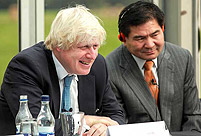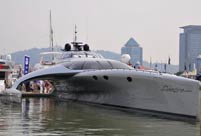BEIJING, Oct. 17 -- "Gentlemen seek harmony but not uniformity." The ancient Chinese philosophy championed by Confucius has had far-reaching influence on the values of the Chinese people.
In the contacts and exchanges with ASEAN countries, China's policy of seeking good-neighborliness, concord and win-win cooperation has perfectly conveyed its diplomatic concept.
At this crucial juncture, when China and ASEAN have witnessed the 10th anniversary of their strategic partnership, China's top leaders proposed new objectives, initiatives and mindsets during their recent visits to the Southeast Asian nations, in a move to lift the bilateral relationship to a higher level.
NEW POLITICAL GOAL -- SEEKING COMMON GROUND WHILE RESERVING DIFFERENCES
Different ethnic groups, political and cultural systems, religious beliefs and development stages have combined to form a diversified Asian landscape. In this expansive context, China and ASEAN have gone through a brilliant "golden decade." Increasingly frequent use of such descriptions as "comprehensive," "strategic" and "partnership" suggests a gradual and steady improvement of their bilateral ties.
Today global political, economic, financial and trade patterns are undergoing an intensive reshuffle, where old and new meet while challenges and opportunities coexist. It is an overriding trend to pursue development, promote peace, and safeguard the interests of the developing world.
Analysts note that respect for each other and non-interference in domestic affairs is the intrinsic nature of the China-ASEAN relationship, and mutual trust and harmony is the common ground. China's defining foreign policy of good-neighborliness has won the trust of ASEAN countries, while in turn Beijing fully supports a stronger ASEAN through unity.
Be there cooperation or dispute, trust or suspicion, the China-ASEAN relationship is always in the limelight. But as reiterated by Chinese President Xi Jinping, building a closer community with neighbors and sharing a common destiny is the correct road to take.
A retrospective look reveals that coexistence in harmony and seeking common ground has always been the bedrock of China-ASEAN ties, despite all the twists and turns.
Confucius once said, "Do not do to others what you do not want done to yourself." The "big powers seek hegemony" talk runs counter to China's traditional wisdom, as Chinese Premier Li Keqiang has said, we should "plant flowers, no thorns."
Vietnamese Prime Minister Nguyen Tan Dung spoke highly of China's consistent policy of building goodwill with its ASEAN neighbors. He believed that with strong political will from all parties, the ASEAN-China strategic partnership will further develop, contributing to regional peace and common development.
NEW INITIATIVE -- MUTUALLY BENEFICIAL AND WIN-WIN APPROACH
Over the past ten years, China and ASEAN have maintained a cordial relationship thanks to political and economic interactions between the two sides. At present, China and ASEAN countries are gathering pace with economic restructuring, thus broadening the scope of cooperation.
China's new initiatives -- to upgrade the China-ASEAN free trade area (FTA), to build a maritime Silk Road and to set up an Asian infrastructure investment bank -- are of practical significance.
The China-ASEAN FTA, the largest one among developing countries, benefits a 1.9-billion population in total. From 2002 to 2012, two-way trade saw an average annual increase of 23.6 percent and topped 400 billion U.S. dollars last year, while the accumulated volume of mutual investments exceeded 100 billion dollars in the same period.
China proposes to launch negotiations on upgrading the FTA with the goal of an uplift in trade volume to a trillion dollars by 2020. In the next eight years, China's total import from ASEAN is set to hit 3 trillion dollars, while its investment to ASEAN is to surpass 100 billion dollars.
China prioritizes continental and maritime connectivity with ASEAN. To accelerate infrastructure construction for better interconnection, China has brought up establishing the Asian infrastructure investment bank. To build a 21st-century maritime Silk Road, China has set up a maritime cooperation fund of 3 billion yuan (491.7 million dollars).
In the financial sector, China suggests expanding the scope of bilateral currency swap and drawing up a roadmap for regional financial cooperation, so as to create a stable system for Asian currencies and an Asian credit system, as well as an investment and financing cooperation system in Asia.
China also signed plans with a number of ASEAN countries on economic and trade cooperation. For instance, China signed respectively with Indonesia and Malaysia a five-year plan with specified new objectives and key areas.
Upgrading the FTA will make it an experimental zone of "Regional Comprehensive Economic Partnership (RCEP)," said Huang Bin, an expert at Thailand's think tank KAITAI Research Center. He said this region will eventually turn into a mega economic zone home to about half of the global population and one-third of the world's total trade volume and output.
Japan's Asahi Shimbun said as the United States is pushing to open markets even further through the TPP negotiations, the Chinese stance is centered more on developing relationships while considering interests of other nations.
NEW SECURITY CONCEPT -- CONSULTATION AND COMPROMISE
"He whoever has had experience with chopsticks understands that one single chopstick won't do the work of putting food in the mouth," Premier Li said, "To do the work, a pair of chopsticks are needed. And when a bunch of chopsticks are tied together, they won't break easily."
Li's metaphor of chopsticks has vividly illustrated China's new security concept, extending a positive political will to settle disputes through negotiation.
The "waves" in the South China Sea, which was supposed to be tranquil and calm, were often made by some ill-disposed media. A fundamental cause is that internal affairs of the region have been complicated by external factors.
More than 100,000 ships of various countries sail across the sea safely every year, but there is still some media hyping up the freedom of navigation. Besides, the principle that the countries directly concerned should address conflicts through consultation and negotiation is not abided by.
Sovereignty and territorial integrity have a stake in a country's core interests and a bearing on national sentiment. In this sense, "harmony is most precious," a Confucianist idea, sheds light on solutions to the conflicts.
The Declaration on the Conduct of Parties in the South China Sea, which was signed a decade ago, embodies China's stances and principles. Today China has explicitly expressed its will to push forward consultations on a code of conduct on the basis of consensus.
Before the conflicts are completely resolved, shelving disputes and seeking joint development is a viable solution. This innovative way of thinking has opened up new possibilities for addressing the conflict.
Experts said progress made during Li's visit has signaled that countries in the region share the wisdom to safeguard maritime peace and turn the South China Sea into a sea of peace, friendship and cooperation.
 No news of survivors in Lao Airlines crash
No news of survivors in Lao Airlines crash China's destroyer Qingdao sails out of Sydney Harbor
China's destroyer Qingdao sails out of Sydney Harbor Chinese tycoon aims to restore London's Crystal Palace
Chinese tycoon aims to restore London's Crystal Palace Admirers to bid joyful goodbye to Rubber Duck
Admirers to bid joyful goodbye to Rubber Duck Photo story: For the last three students
Photo story: For the last three students  Photo story: A day in the life of a car model
Photo story: A day in the life of a car model Chinese screen goddesses from Beijing Film Academy
Chinese screen goddesses from Beijing Film Academy  Weekly Sports Photos
Weekly Sports Photos World's most amazing yacht on display in Guangzhou
World's most amazing yacht on display in Guangzhou Photo collection of Chinese Navy
Photo collection of Chinese Navy Cold air sweeps through N China
Cold air sweeps through N China The last family in shantytowns
The last family in shantytowns UNESCO world heritage site: Montale Tower
UNESCO world heritage site: Montale Tower U.S. Senate leader announces bipartisan deal
U.S. Senate leader announces bipartisan deal Fiber-optic wedding dress show shinning in Suzhou
Fiber-optic wedding dress show shinning in Suzhou Day|Week|Month